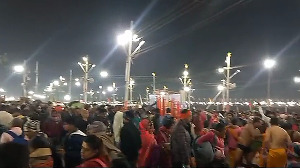In the entire din surrounding the impact of the Special Economic Zones there is not much information on the impact of these zones on the water situation in the areas around these zones. Finance Minister P Chidambaram has been credited with a very interesting statement, "Where infrastructure already exists, it is perhaps not necessary to create SEZs". The trouble is, in backward areas where infrastructure is weak, the impact of SEZ on access to water would be even more serious.
Broadly, there are three kinds of impacts that SEZ can have on access to water for the people in the SEZ area. First would be due to the diversion of water for use within the SEZ. Second impact would be the impact of release of effluents from the SEZ. Here the situation at locations like Ankleshwar in Gujarat and Patancheru in Andhra Pradesh, among scores of other places is illustrative. At these places, the release of untreated effluents from the industrial estates has created a hell for the residents of the area. Our past performance in achieving effective pollution control is dismal, to put it most benevolently. And there is absolutely no movement to change that situation.
Thirdly, the conversion of land to SEZ would mean destruction of groundwater recharge systems. It should be remembered here that in India, right to extract groundwater continues to be connected with the ownership of land. Hence SEZs even in a relatively small area can pump out huge quantity of water, drying up the wells of the surrounding area. There could be conflicts between the zones and the local residents, as could be seen at Plachimeda in Kerala, as also in Varanasi and Jaipur.
Cumulatively, the impact of all these could be quite serious in most areas, and could precipitate a crisis in the water scarce areas.
Land Requirement for SEZs: According to the website of the commerce ministry, totally about 41,700 hectares of land is to be taken for the formally approved and notified SEZs. When land is acquired on such massive scale, the water requirement for such SEZs would be huge and would have very large impact on water access for the surrounding area.
Water Sources: The government Govt of India SEZ Act of 2005 has no mention of the sources of water for the proposed zones, leave aside the question of restrictions or impact assessment. In fact, the only time the Act mentions water, it is in the context of territorial waters of India. The SEZ acts or orders or notifications of various states give a blank cheque to the water requirement for the zones. For example, the Gujarat Act says, "The SEZ developer will be granted approval for development of water supply and distribution system to ensure the provision of adequate water supply for SEZ units." Similar is the situation for other states.
Available information about the water needs and sources of water for various SEZs should ring alarm bells.
- Navimumbai SEZ: As per official website, it will require at least 6 million liters per day, expects it to get from Hetwane dam.
- Mundra SEZ: As per official website of the SEZ, it expects to get at least 6 million liters per day from the Sardar Sarovar project, as promised by Gujarat Water Infrastructure Ltd. Ultimate water requirement would be 400 million litres per day. Here it is relevant to note that the report of the Comptroller and Auditor General of India for Gujarat for the year ending on March 31, 2006 has already criticised Gujarat government govt for extra allocation of 41.1 million litres per day water from the Sardar Sarovar Project for industries. The CAG report said that this will affect share of water for drought prone areas.
- POSCO SEZ: The water requirement, as given on the POSCO website, is 286 million litres per day, will be procured from Jobra barrage on the Mahanadi River in Cuttack, district in Orissa. The water for this is bound to come from the upstream Hirakud dam. There is already an agitation against reservation of water from the Hirakud dam for industrial use.
- Nagpur IT Park SEZ: The official website says, "The water will be drawn from irrigation project' in a document inviting expression of interest.
- Mangalore SEZ: In a letter in June 20006 to Prime Minister Manmohan Singh, the convener of the SEZ Impact Assessment Committee, an affiliate of the NGO Forum of Mangalore, has quoted the Mangalore SEZ Limited having estimated the water need at 136 million litres of water a day. With Mangalore city is facing water crisis without the SEZ, one can imagine what will be the case when SEZ comes up.
- Cochin SEZ: The website of the Cochin SEZ (www.CSEZ.com) says, "The Special Economic Zone is a foreign territory within India . CSEZ has an integrated water management system comprising a 1.5 MLD water supply system and a 1 MLD common effluent treatment plant."
One can already see the seeds of conflict that these water allocations would create. If these tips are any indication, implementation of these SEZ will create crisis of access to water for the people staying in areas around the proposed SEZs.
On World Water day this year, Prime Minister Manmohan Singh said, "We cannot allow human societies to descend into chaos due to conflict on utilisation of water resources". Action speaks louder than words, Mr Prime Minister.
Let us see what his government does to address the conflicts that SEZs are creating. A lot needs to be done to ensure that water use at these SEZs do not become seeds of bigger crisis in the days to come. Going by the track record such hope does not seem realistic.
Himanshu Thakkar is the founder of the NGO -- South Asia Network on Dams, Rivers & People






 © 2025
© 2025